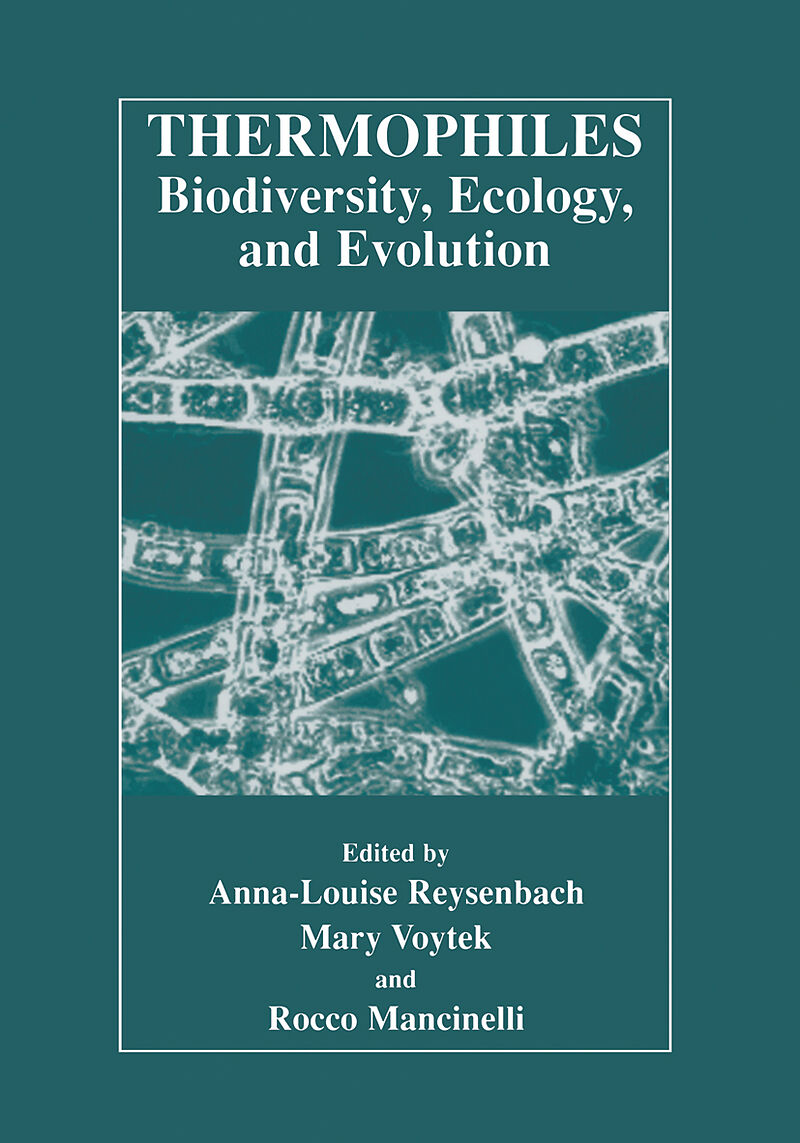Thermophiles: Biodiversity, Ecology, and Evolution
Einband:
Fester Einband
EAN:
9780306461651
Untertitel:
Biodiversity, Ecology, and Evolution
Genre:
Medizin
Herausgeber:
Springer, Berlin
Auflage:
2001 edition
Anzahl Seiten:
205
Erscheinungsdatum:
2001
ISBN:
978-0-306-46165-1
These are indeed exciting times to be a microbiologist. With one of the buzzwords of the past decade-"Biodiversity," and microbes are reveling in the attention as they represent by far most of the biodiversity on Earth. Microbes can thrive in almost any environment where there is an exploitable energy source, and, as a result, the possible existence of microbial life elsewhere in the solar system has stimulated the imaginations of many. Extremophiles have taken center stage in these investigations, and thermophiles have taken on the lead roles. Consequently, in the past decade there has been a surge of interest and research in the Ecology, Biology, and Biotechnology of microorganisms from thermal environments. Many of the foundations of thermophile research were laid in Yellowstone National Park, primarily by the research of Professor Thomas Brock's laboratory in the late 1960s and early 1970s. The upper temperature for life was debated, the first thermophilic archeum discovered (although it was only later shown to be an archeum by ribosomal cataloging), and the extremes of light, temperature, pH on the physiology of microorga nisms were explored. Interest in thermophiles increased steadily in the 1970s, and with the discovery of deep-sea hydrothermal vents in 1977, thermophilic research began its expo nential explosion. The development of Taq polymerase in the polymerase chain reaction (peR) focused interest on the biotechnological potential of thermophilic microorganisms and on the thermal features in Yellowstone National Park.
Inhalt
1 The Origins of Research on Thermophiles.- 1. Introduction.- 2. Early Bacteriological Research on Thermophiles.- 3. Ecological Observations of Geothermal Environments.- 4. Yellowstone National Park.- 5. Thermus Aquaticus.- 6. Discovery of Extreme Thermophiles.- 7. Thermoplasma, Sulfolobus, and the Archaea.- 8. Yellowstone Research and the Deep-Sea Thermal.- 9. Microbial Prospecting in Thermal Habitats.- 10. Conservation of Yellowstone's Thermal Resources.- 11. Summary.- References.- 2 Deep-Sea Thermophilic Prokaryotes.- 1. Introduction.- 2. Hydrothermal Vent Environments.- 3. Biological Communities.- 4. Ecological Studies.- 5. Diversity: Thermophilic and Hyperthermophilic Isolates.- 6. Assessments of Molecular Diversity.- 7. Bioprospecting and Biotechnology.- 8. Hydrothermal Vents and the Origin of Life.- 9. Summary.- References.- 3 Biodiversity of Acidophilic Moderate Thermophiles Isolated from Two Sites in Yellowstone National Park, and Their Roles in the Dissimilatory Oxido-Reduction of Iron.- 1. Introduction.- 2. Materials and Methods.- 3. Results.- 4. Discussion.- 5. Summary.- References.- 4 Presence of Thermophilic Naegleria Isolates in the Yellowstone and Grand Teton National Parks.- 1. Introduction.- 2. Materials and Methods.- 3. Results.- 4. Discussion.- 5. Summary.- References.- 5 Examining Bacterial Population Diversity Within the Octopus Spring Microbial Mat Community.- 1. Introduction.- 2. Octopus Spring Mat Cyanobacterial Diversity as Revealed by Microscopy, Cultivation, Probing, Cloning, and Sequencing.- 3. Standardization of Methodology, Environmentally Meaningful Sampling Points, and Increased Sample Throughput are Necessary to Understand Octopus Spring Population Dynamics.- 4. DGGE Analysis of Octopus Spring Mat Samples.- 5. DGGE Analyses of AerobicChemoorganotrophic Enrichment Cultures Demonstrates the Incongruence among Populations within Natural Microbial Communities and Those Obtained from Selective Enrichment Cultures.- 6. Summary.- References.- 6 Direct 5S rRNA Assay for Microbial Community Characterization.- 1. Introduction.- 2. Materials and Methods.- 3. Results.- 4. Discussion.- 5. Summary.- References.- 7 Community Structure Along a Thermal Gradient in a Stream near Obsidian Pool, Yellowstone National Park.- 1. Introduction.- 2. Materials and Methods.- 3. Results.- 4. Discussion.- References.- 8 Isolation of Hyperthermophilic Archaea Previously Detected by Sequencing rDNA Directly from the Environment.- 1. Introduction.- 2. Materials and Methods.- 3. Results.- 4. Summary.- References.- 9 Thermophilic Anoxygenic Phototrophs Diversity and Ecology.- 1. Introduction.- 2. Diversity and Phylogeny of Hot Spring Anoxyphototrophs.- 3. Physiology of Hot Spring Anoxyphototrophs.- 4. Ecological Studies of Thermophilic Anoxyphototrophs.- 5. Conclusions.- References.- 10 Algal Physiology at High Temperature, Low pH, and Variable pC02 Implications for Evolution and Ecology.- 1. Introduction: Why the Microbial Mats of Yellowstone.- 2. Material and Methods.- 3. Results.- 4. Discussion.- 5. Summary.- References.- 11 The Zonation and Structuring of Siliceous Sinter Around Hot Springs, Yellowstone National Park, and the Role of Thermophilic Bacteria in Its Deposition.- 1. Introduction.- 2. Geologic Setting of Yellowstone Geothermal System.- 3. Morphological Subdivisions of Outflow Systems.- 4. Temperature and Bacterial Subdivisions of Outflow Systems.- 5. The Role of Bacteria in the Deposition and Structuring of Siliceous Sinter.- 6. Discussion.- 7. Summary.- References.- 12 Use of 16S rRNA, Lipid, and Naturally PreservedComponents of Hot Spring Mats and Microorganisms to Help Interpret the Record of Microbial Evolution.- 1. Introduction.- 2. 16S rRNA Biomarker Studies Link Biodiversity, Ecology, and Evolution.- 3. Lipid Biomarker Studies Help Link Chemical Fossils to Their Microbial Sources.- 4. Naturally Preserved Biomarkers can be Related to Their Microbial Sources.- 5. Summary.- References.- 13 Research Accomplishments of a Small Business Using Yellowstone's Extremophiles.- 1. Introduction.- 2. Results and Discussion.- 3. Conclusions.- References.- 14 The Yellowstone Microbiology Program Status and Prospects.- 1. Introduction.- 2. Inventory and Monitoring of YNP Microorganisms.- 3. Microbiological Research Support.- 4. Protection of Geothermal Habitat.- 5. Benefit-Sharing/Bioprospecting.- 6. Education.- 7. Summary.- Appendix I.- Appendix II.- References.

Leider konnten wir für diesen Artikel keine Preise ermitteln ...
billigbuch.ch sucht jetzt für Sie die besten Angebote ...
Die aktuellen Verkaufspreise von 6 Onlineshops werden in Realtime abgefragt.
Sie können das gewünschte Produkt anschliessend direkt beim Anbieter Ihrer Wahl bestellen.
Loading...
Die aktuellen Verkaufspreise von 6 Onlineshops werden in Realtime abgefragt.
Sie können das gewünschte Produkt anschliessend direkt beim Anbieter Ihrer Wahl bestellen.
| # | Onlineshop | Preis CHF | Versand CHF | Total CHF | ||
|---|---|---|---|---|---|---|
| 1 | Seller | 0.00 | 0.00 | 0.00 |
